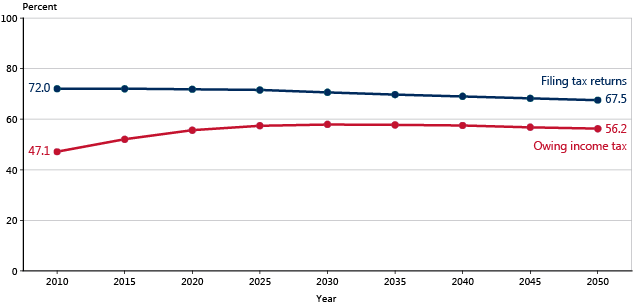Income Taxes on Social Security Benefits
December 2016Since 1984, the proportion of beneficiary families whose benefits are taxed has risen over time from less than one in 10 to more than half
Because the income thresholds that define taxable benefits are not indexed to prices or wages, the proportion of beneficiaries who pay income tax on their benefits has risen over time.
Projections1 show that an annual average of about 56 percent of beneficiary families will owe federal income tax on their benefits from 2015 through 2050
Among beneficiary families that owe income tax on their benefits, the median percentage of benefits owed as income taxes will increase from about 11 percent in 2015 to 12 percent in 2025 and remain stable through 2050.
These projections assume that Congress will amend the Internal Revenue Code provisions that require tax-bracket adjustments based on price indexing
Such amendments would assure that the proportion of income paid as income tax would remain close to its current level. Otherwise, the future percentage of Social Security benefits owed as income tax will exceed the projections.
Background
- Since 1984, Social Security beneficiaries with total income exceeding certain thresholds have been required to pay federal income tax on some of their benefit income.
- The 1983 Social Security amendments set the benefit income taxation thresholds at a modified adjusted gross income—
which includes one-half of Social Security benefit income— of greater than $25,000 for single beneficiaries and $32,000 for married couples.
1 Projections made using Modeling Income in the Near Term, Version 7 (MINT7) microsimulation model using 2012 Trustees Report intermediate assumptions.

| Year | Filing tax returns | Owing income tax |
|---|---|---|
| 2010 | 72.0 | 47.1 |
| 2015 | 72.0 | 52.0 |
| 2020 | 71.8 | 55.6 |
| 2025 | 71.5 | 57.4 |
| 2030 | 70.6 | 57.9 |
| 2035 | 69.7 | 57.7 |
| 2040 | 69.0 | 57.5 |
| 2045 | 68.2 | 56.8 |
| 2050 | 67.5 | 56.2 |
SOURCE: Purcell, Patrick J. Income Taxes on Social Security Benefits. Social Security Administration Issue Paper 2015-02.
NOTES: All content is simplified for presentation. Please see source material for full details and caveats.
The findings and conclusions presented in this summary are those of the authors and do not necessarily represent the views of the agency.